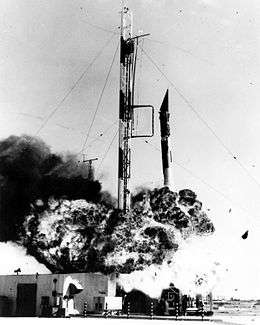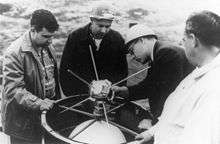Vanguard TV3
 The Vanguard rocket explodes shortly after launch. | |
| Mission type | Earth science |
|---|---|
| Operator | Naval Research Laboratory (NRL) |
| Spacecraft properties | |
| Launch mass | 1.36 kilograms (3.0 lb)[1] |
| Start of mission | |
| Launch date | December 6, 1957, 16:44:34 UTC |
| Rocket | Vanguard |
| Launch site | Cape Canaveral LC-18A |
| Orbital parameters | |
| Reference system | Geocentric |
| Epoch | Planned |
Vanguard TV3, also called Vanguard Test Vehicle Three was the first attempt of the United States to launch a satellite into orbit around the Earth. Vanguard 1A was a small satellite designed to test the launch capabilities of the three-stage Vanguard and study the effects of the environment on a satellite and its systems in Earth orbit. It was also to be used to obtain geodetic measurements through orbit analysis. Solar cells on Vanguard 1A were manufactured by Bell Laboratories.
At its launch attempt on December 6, 1957 at Cape Canaveral, the booster ignited and began to rise; but about two seconds after liftoff, after rising about four feet (1.2 m), the rocket lost thrust and began to fall back to the launch pad. As it settled the fuel tanks ruptured and exploded, destroying the rocket and severely damaging the launch pad. The Vanguard satellite was thrown clear and landed on the ground a short distance away with its transmitters still sending out a beacon signal. The satellite was damaged, however, and could not be reused. It is now on display at the National Air and Space Museum of the Smithsonian Institution.[1]
The exact cause of the accident was not determined with certainty due to limited telemetry instrumentation at this early phase,[2] but Martin-Marietta concluded that low fuel tank pressure during the start procedure allowed some of the burning fuel in the combustion chamber to leak into the fuel system through the injector head before full propellant pressure was obtained from the turbopump. GE on the other hand argued that the culprit was a loose fuel connection. The actual truth appeared to be somewhere in-between as the two seconds of telemetry data from TV-3 indicated a sudden pressure surge at ignition which caused the rupture of a fuel line. GE technicians had failed to catch this design flaw during testing and it was ultimately solved by increasing tank pressure and also injecting the LOX into the combustion chamber 3–6 seconds before RP-1 injection. The X-405 engine did not fail again on subsequent launches and static firing tests.

Satellite construction project
The history of the Vanguard TV3 project dates back to the International Geophysical Year (IGY). Initiated in 1952, orbiting a satellite became one of the main goals of the IGY. This was an enthusiastic international undertaking that united scientists globally to conduct planet-wide geophysical studies. The IGY guaranteed free exchange of information acquired through scientific observation which led to many important discoveries in the future.[3] As early as July 1955, President Dwight D. Eisenhower announced, through his press secretary, that the United States would launch "small, unmanned, earth-circling satellites as part of the U.S. participation in the I.G.Y." [4] On September 9, 1955, the United States Department of Defense wrote a letter to the secretary of the Navy authorizing the mission to proceed. The US Navy had been assigned the task of launching Vanguard satellites as part of the program. Project Vanguard had officially begun.[5]
Satellite design
The payload of the TV3 was very similar to the later Vanguard 1. It was a small aluminium sphere, 15.2 cm in diameter and with a mass of 1.36 kg. It carried two transmitters: a 10-mW, 108-MHz transmitter powered by a mercury battery, and a 5-mW, 108.03-MHz transmitter powered by six solar cells mounted on the body of the spacecraft. Using six small aerial antennae mounted on its body, the satellite primarily transmitted engineering and telemetry data, but the transmitters were also used to determine the total electron content between the satellite and the ground stations. Other instruments in the satellite's design included two thermistors, which were used to measure the satellite's internal temperatures for the purpose of tracking its thermal protection's effectiveness. Although the satellite was damaged beyond reuse capability during the crash, it was still intact and transmitting after the incident.[1]
Launch vehicle design
The Vanguard TV3 utilized a three-stage launch vehicle known as the Vanguard designed to send the satellite into orbit around the earth. The fins were removed from the rocket as a way to reduce the drag, but instead, a big motor is mounted in gimbals which allow it to pivot and direct its thrust for steering. The same feature is similarly rigged for the second and third stages of the rocket as well.[6]
The first stage allows the rocket to rise vertically under the powerful thrust of burning liquid oxygen, ethyl alcohol, gasoline and silicone oil which propels the vehicle at a rate of 4000 miles per hour, lifting the satellite through the denser layers of the atmosphere in 130 seconds. At this point, the second stage burns its fuel carrying it away from the stage one motor and tanks. The satellite rises to an altitude of 300 miles above the earth. The flight path has been programmed to change from a vertical into a more horizontal course. Then, the third stage takes over to provide spin and the final boost, shoving stage three horizontally into orbit at the rate of 18000 miles per hour. The satellite slowly disengaged from the third-stage rocket where at this speed, the satellite falls toward earth at the same rate earth’s surface curves away from it. As a result, the satellite’s distance from the earth remains about the same.[7]
Reaction
As a result of the launch failure, trading in the stock of the Martin Company, prime contractor for the project, was temporarily suspended by the New York Stock Exchange.[2]
Newspapers in the United States, published prominent headlines and articles noting the failure including plays on the name of the Russian satellite, Sputnik, such as "Flopnik",[8] "Kaputnik",[9] "Oopsnik", and "Stayputnik".[10]
Later analysis of this technological failure characterized this as a humiliation and loss of prestige for the United States which had presented itself to the world as the leader in science and technology. Its rival in the Cold War, the Soviet Union, exploited this at the time.[11][12] The Americans' failed attempt of launching a satellite was an international embarrassment on their part for wanting to publicly show in front of media through television and newspaper cameras from around the world. A few days after the incident, a Soviet delegate to the United Nations inquired solicitously whether the United States was interested in receiving aid earmarked for "undeveloped countries".[13]
Eventually, the concurrent project Explorer 1 proved successful a few weeks later, on the 01st February 1958.
External links
- YouTube - Vanguard (Flopnik) (in black and white)
- YouTube - Vanguard TV3 Failed Rocket Launch (in color)
- Google Newspapers - The Ottawa Citizen - "US fails to fire Satellite"
References
- 1 2 3 "Vanguard TV3". NSSDC Master Catalog. NSSDC, NASA. Retrieved 2011-02-26.
- 1 2 McLaughlin Green, Constance; Lomask, Milton (1970). "Chapter 11: From Sputnik I to TV-3". Vanguard - A History. NASA. Retrieved 2011-02-26.
- ↑ Lina Kohonen. "The Space race and Soviet utopian thinking" Sociological Review; Vol. 57, May 2009, page 114
- ↑ John P. Hagen, "The Viking and the Vanguard", in Technology and Culture, Vol. 4, No. 4, (Baltimore: The Johns Hopkins University Press), Autumn 1963, page 437)
- ↑ John P. Hagen, "The Viking and the Vanguard", in Technology and Culture, Vol. 4, No. 4, (Baltimore: The Johns Hopkins University Press), Autumn 1963, page 439)
- ↑ Fred L. Whipple & J. Allen Hynek, "Stand by for Satellite Take-off" in Popular Mechanics Magazine, H.H. Windsor Jr, Illinois: the Hearst Corporation, July 1957 issue, page 66.
- ↑ Fred L. Whipple & J. Allen Hynek, "Stand by for Satellite Take-off" in Popular Mechanics Magazine, H.H. Windsor Jr, Illinois: the Hearst Corporation, July 1957 issue, page 67.
- ↑ Sparrow, Giles (2007). Space Flight. Dorling Kindersley. ISBN 0-7566-2858-X.
- ↑ Burrows, William E. (1999). This New Ocean: The Story of the First Space Age. Modern Library. p. 205. ISBN 0-375-75485-7.
- ↑ Alan Boyle (1997-10-04). "Sputnik started space race, anxiety". MSNBC. Retrieved 2008-03-17.
- ↑ Catchpole, John (2001). Project Mercury: NASA's First Manned Space Program. p. 56. ISBN 1-85233-406-1.
- ↑ Jones, Thomas (2002). "Early Frustrations: Project Kaboom (A.K.A Vanguard)". Complete Idiots Guide to NASA. ISBN 0-02-864282-1.
- ↑ Charles A. Murray & Catherine Bly Cox, in Apollo: The Race to the Moon. (United States of America: Simon & Schuster Inc.), 1989, page 23-24)